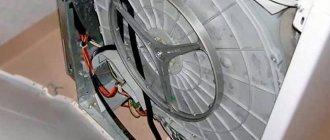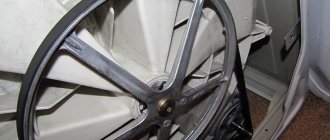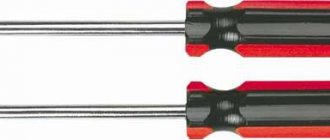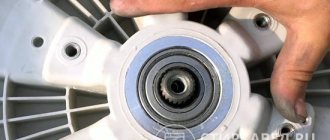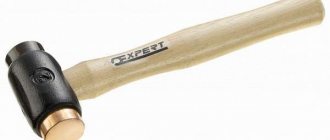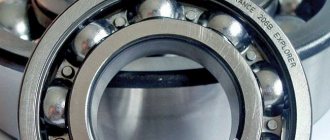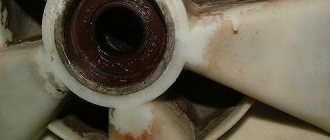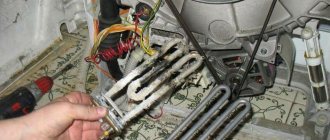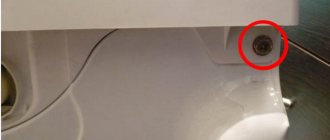The belt in a washing machine is a very important part that is necessary to rotate the drum. It fits over the engine and onto the pulley that is bolted to the engine.
To set the drum in motion, you need to start the motor, from which the rotation is transferred to the pulley. There is nothing complicated in the design of this design and it is often used in a wide variety of industrial sectors. If the belt falls off for some reason, the drum of the machine will not spin. In this case, you need to return the belt to its original place. How to do it right? Let's discuss in this article.
Why do you need a belt in a washing machine?
The belt is one of the most important parts in the operation of a washing machine from Haier, Hansa, Indesit, Kaiser and other brands. It is designed to ensure safe and even rotation of the drum. The belt connects the motor and a pulley attached to the drum. When the engine begins to rotate, the pulley also rotates, thereby turning the drum of the machine.
A broken belt or its regular displacement makes it difficult for Beko, Favorit, Siltal, Liliya and other brands of washing machines to operate evenly, which is why the safety and correctness of the belt connection should be constantly monitored.
Design features and signs of breakdowns
The belt in washing machines connects the drum pulley and the electric motor used. Its main purpose is to transmit torque; accordingly, the drive often fails due to excessive load. Many manufacturers indicate the service life of the entire structure is about 10 years. However, in most cases, after 3-5 years of active use of the washing machine, the first symptoms of a stretched drive are noted.
Many modern washing machines have built-in automation; accordingly, if there are such faults, the corresponding error codes are displayed on the built-in display. Visually, such breakdowns can also be identified by characteristic signs, including increased vibration, lack of rotation and the appearance of extraneous sounds.
The main signs of a drum drive malfunction:
- the drum does not rotate after starting the program;
- the engine runs, but the drum assembly does not rotate;
- the drum can rotate only with a minimum load;
- the appearance of extraneous sounds, including friction and grinding;
- Automation freezes after starting the machine.
If you have all such symptoms of problems, you should immediately turn off the equipment, disassemble it, put a belt on the washing machine, or contact a specialized service.
If a homeowner still tries to wash clothes with problems with drum rotation and a broken drive, this can lead to serious malfunctions, including the need to completely replace the control automation and electric motor.
Is this a belt?
It is difficult to immediately understand that the belt has fallen off - it is located behind the rear panel of the machine body. To check your guess, you will have to unscrew the bolts and remove the wall. However, the washing machine itself can also “hint” at problems with the drive. How to determine that the reason the equipment stops working lies precisely in a broken rubber band?
Having detected that the drive belt has “flyed away”, the machine will immediately inform the user about the malfunction. Machines with a display will display an error code on the display. All that remains is to look at the instructions and decipher the designation. Washing machines that are not equipped with a screen will indicate the problem by flashing indicators on the control panel.
In some cases, the “brain” of the machine does not notice the broken belt. Then the user will have to guess the cause of the machine breakdown based on indirect symptoms. You need to think about problems with the drive system if:
- the washing machine has started the program, the tank is filled with water, the engine is running, but the drum does not even think about rotating;
- The engine of the machine hums, then suddenly “goes silent” and stops working. Such a change in engine states is observed at regular intervals;
- the washing starts, the electric motor runs continuously, but the machine “freezes” and does not “respond” to the user’s commands;
- The drum rotates well by hand, but the electric motor does not start working.
If one of the “symptoms” is detected, you should urgently check the drive system of the Bosch washing machine. Operating a machine with a broken drive belt is dangerous, as this will lead to overheating and engine failure. To check if the rubber is in place, you will need a screwdriver. Let us describe the basic algorithm of actions when conducting diagnostics.
Causes of drive damage
There can be many reasons for the drive stretching and breaking. This is both physical fatigue of the belt, which becomes unusable due to significant loads, and improper operation of the washing machine. In each specific case, the repair will be different. If the problem is only a slipped belt, then it is quite possible to install a new drive or tighten it, restoring the equipment yourself. Whereas if there is a break with engine failure, then in such a case you need to contact professionals.
Belt problems may occur in the following cases:
- Wear of the fastening pulley leads to increased wear, after which the drive slips off or breaks, which leads to jamming of the drum.
- A loose and unreliable motor mount causes distortions and incorrect drive tension, which leads to it slipping out of the grooves.
- Physical wear and tear of metal, which is observed on equipment that has been in use for 10 years or more.
- Bearing wear causes vibrations in the drum pulley and drive, which fly off or rupture, leading to failure of the electric motor.
- Deformation of the shaft and pulley causes disruption and weakening of the fasteners, and breakdowns of the crosspiece and shaft occur. Increased vibration can cause complex damage to the washing machine.
- Weak motor tension is observed when it is physically worn out or when the drive is incorrectly selected during repair and maintenance of equipment.
- Frequent, prolonged downtime of the equipment leads to stiffening of the belt and loss of its elasticity. As a result, during one of the starts the drive simply breaks or flies off the shaft.
- Loosening of the drum cross requires balancing of the equipment, otherwise strong vibration occurs, which affects all components.
- Deformation of the plastic tank can increase the static load on the drive, which loses its strength and may soon fly off or break.
The homeowner should diagnose and repair the equipment at the first sign of a malfunction.
A break in the drive can lead to failure of automation, various internal units and expensive models. In such a case, the electric motor, which is one of the most expensive components, often suffers. Place the belt on the drum of the washing machine, so you can do the repair yourself.
Signs that a part requires replacement
The need to replace a belt is not a common problem. Worn parts can become noticeable during prolonged or improper use of the washing machine.
The average service life of a washing machine belt is 6 years. The need for replacement during longer use is a normal situation.
Incorrect operation with regular violation of the rules, for example, overloading laundry, can accelerate the wear of a part.
In some cases, a problem with the drive belt may be indicated by a complete stop of the washing machine and the display of code E4, UE, UB. On machines not equipped with a display, all mode lights blink and the second temperature indicator from the top lights up.
A problem with the drive belt does not always cause an error code to appear.
It is necessary to pay attention to the following failure situations:
- when water is filled into the drum and the motor is running, the drum does not rotate;
- the engine runs intermittently;
- after the start of the work cycle, despite the engine running, a freeze occurs;
- free rotation of the drum when the engine is not running.
- Uncharacteristic noise when washing.
If the part itself has a rough surface, pellets have formed on the surface and on the elements that are in contact with the belt, or delamination, then replacement is definitely needed. But this can only be determined through direct access.
If problems with the drive belt occur frequently, professional diagnostics of the machine by a specialist is necessary.
What is a drive belt?
The drive belt is an important part in a washing machine. Thanks to it, the drum rotates, without which washing is impossible
The belt is the connecting link between the drum pulley and the engine, and if it breaks or falls off, the machine stops working. The service life of the drive belt is many years with proper care of the machine.
Can. If the drum makes a scraping sound when rotating and spins very easily by hand, then most likely this is the problem.
Why does the belt come off on a washing machine?
When the drum is overloaded, spinning occurs, which leads to the belt falling off.
It happens that a similar situation is repeated and the washing machine belt constantly falls off, then you cannot do without professional diagnostics and help.
The most common causes of belt problems can be:
- Unreliable fastening of the drum pulley. The belt will definitely fly off or break if the fastenings that hold the drum are weak and move from side to side. As a result, the drum may completely jam.
- Engine mounting problems. Just like a pulley, the fastenings can become loose and the belt will not be tensioned enough, causing it to slip. To solve the problem you need to remove the back cover of the machine and tighten the fastenings. Put the belt in place.
- Belt wear due to long use. The belt stretches due to long use and ceases to perform its function. When cranking, the machine whistles and barely spins. And sometimes the machine stops working completely.
Bearing wear. For this reason, the drum may become askew and, as a result, the belt on the washing machine naturally falls off. You may need the help of an experienced technician.
The shaft or pulley is deformed. When a belt comes off in a washing machine, the pulley can bend and damage important parts of the appliance.
Weak belt tension. If the drive belt is not tensioned correctly or it is of the wrong size, then it is inevitable that it will fall. When buying a belt, you need to focus on a worn belt installed by the manufacturer or trust the help of a professional.
Rare use of the machine. It turns out that infrequent use also causes problems with the drive belt, because it can dry out, crack and lose elasticity.
The drum cross has become loose. Such an imbalance is also a direct cause of the drive belt coming off.
Choice to replace
How to properly install a belt on a washing machine? First you need to purchase a similar product that is suitable for your SMA.
Models with asynchronous motors use a wedge type. Its cross section is compared to a triangle or trapezoid. Due to the rigidity of the material, they rarely tear. You can determine their number and brand by the designation on the outside.
A feature of the installation of a wedge-like product is considered to be strong tension and a slight deflection in the middle part.
For the SM commutator motor, poly-wedge products are used. Consists of several toothed wedges.
How to tension the drive belt in this case? The installation differs from the wedge one - it is not tensioned so much. However, in some models of narrow machines, this poly-wedge type can be put on very tightly. Therefore, you will need to use more force for installation.
To buy a belt in a specialized store, just name the make and model of the car, after which the seller will offer a suitable option.
Both installing a broken belt and replacing a drive belt in a washing machine is not at all difficult, and the work is done in the same way.
First, complete the preparatory phase. Unplug the washing machine. Close the water inlet valve. Prepare a container to collect water. After unscrewing the intake hose from the back wall, drain the remaining water into a container. Now you can start disassembling.
To do this, take a Phillips screwdriver and unscrew the screws around the perimeter of the back cover of the SMA. Putting the cover aside, inspect the belt, as well as nearby parts - wiring and sensors - for damage.
If everything is in order, it's time to learn how to change the belt. Replacement of wedge and poly wedge products is carried out in the same way. For this:
- Pull the product first onto the electric motor shaft, and then onto the drum pulley.
- While doing this, pull the belt with one hand and turn the pulley with the other.
Now you know how to insert the belt into the washing machine, so carefully inspect the installation location - it should be located clearly in the groove. All that remains is to reinstall the back panel, secure it with bolts and connect the SM to communications and the network.
Start the car and check the functionality of the new belt.
As you can see, you can change the belt yourself at home. Be careful, because some products are so tight that you will have to apply a lot of force to tighten them.
Increasingly, manufacturers are giving preference to direct drive motors, as these motors have a long service life and are characterized by higher efficiency. At the same time, motors with torque transmission to a belt remain relevant. They are easier to repair and are not so sensitive to voltage surges. The main function of the belt is to transmit torque from the motor shaft to the drum of the washing machine.
As a result of prolonged use, the belt may wear out or break completely. In this case, the motor will idle - the motor shaft will rotate, but the drum will stand still. To replace the belt, you will need to disassemble the washing machine, so we recommend contacting our service center - professionals in their field will return your “assistant” to operation in a short time.
Wedge type
Models with asynchronous motors use a wedge type. Its cross section is compared to a triangle or trapezoid. Due to the rigidity of the material, they rarely tear. You can determine their number and brand by the designation on the outside.
A feature of the installation of a wedge-like product is considered to be strong tension and a slight deflection in the middle part.
Poly V-type
For the SM commutator motor, poly-wedge products are used. Consists of several toothed wedges.
How to tension the drive belt in this case? The installation differs from the wedge one - it is not tensioned so much. However, in some models of narrow machines, this poly-wedge type can be put on very tightly. Therefore, you will need to use more force for installation.
To buy a belt in a specialized store, just name the make and model of the car, after which the seller will offer a suitable option.
How to buy the right analogue
Many people make mistakes with the belt marking when purchasing. It is recommended to first remove the old element and take it with you to buy an exact replacement. The seller will inspect it, clarify the markings and offer you the desired option. In addition, you can use the Internet to purchase, but you will still have to indicate the exact labeling of the product. Most often, the following markings are purchased for Indesit washing machines:
- MEGADYNE EL 1187 (1195) H7;
- HUTCHINSON 8PHE 1195;
- CONTITECH EL 1195 H7 and others.
When choosing a replacement part, be sure to check its length and type. For Indesit machines, two types are installed - wedge and half-wedge. The first type is found in machines with an asynchronous motor; the cross-section resembles a triangle or trapezoid. The main difference is increased tension, small deflection in the center.
A product in the form of a half-wedge is used in SMA with a commutator motor. The element is a gear train and is tensioned somewhat weaker.
Do-it-yourself step-by-step work
Both installing a broken belt and replacing a drive belt in a washing machine is not at all difficult, and the work is done in the same way.
First, complete the preparatory phase. Unplug the washing machine. Close the water inlet valve. Prepare a container to collect water. After unscrewing the intake hose from the back wall, drain the remaining water into a container. Now you can start disassembling.
To do this, take a Phillips screwdriver and unscrew the screws around the perimeter of the back cover of the SMA. Putting the cover aside, inspect the belt, as well as nearby parts - wiring and sensors - for damage.
If everything is in order, it's time to learn how to change the belt. Replacement of wedge and poly wedge products is carried out in the same way. For this:
- Pull the product first onto the electric motor shaft, and then onto the drum pulley.
- While doing this, pull the belt with one hand and turn the pulley with the other.
Now you know how to insert the belt into the washing machine, so carefully inspect the installation location - it should be located clearly in the groove. All that remains is to reinstall the back panel, secure it with bolts and connect the SM to communications and the network.
Start the car and check the functionality of the new belt.
As you can see, you can change the belt yourself at home. Be careful, because some products are so tight that you will have to apply a lot of force to tighten them.
How to replace the belt on a Samsung washing machine
Washing machines manufactured by Samsung have a cover located at the back that is not removable. This always makes it very difficult to eliminate unit breakdowns.
To fix the problem, you will need:
- The same belt - should be selected with markings identical to the failed one;
- A piece of electrical tape no more than 15 centimeters long;
- Half a meter of wire 0.5-0.8 millimeters thick;
- Wire cutters;
- A flashlight or any other device that can become a light source;
- Crosshead screwdriver.
Before starting repairs, inspect the gear and drum pulley. The gear has several compartments for the belt mates. It is installed from top to bottom. When installing a new belt in place of the old one, it is important to correctly get to where the failed element was previously. If it gets too close to the gear, it will not be clear how correctly it is installed. There is a possibility that in this case part of the belt will either sag or stand on the edge of the pulley and then the repair work will have to be repeated.
After the strap is put on the gear, it needs to be moved slightly to the side. It is important to choose a pulley position where it has support from turning the equipment, which, as a rule, constantly tries to move to the opposite side, on which it will stop thanks to the stop.
Use electrical tape to secure the strap. To protect it from damage, a wire is useful - place it on top of the electrical tape, forming about 10 turns and secure its edges by twisting them together. Rotate the pulley until the belt fits properly.
If the actions were performed correctly, you will hear a kind of click. You won't be able to turn the strap because it is securely fixed with the lock you made.
Now you should turn the gear in the opposite direction, and then remove the electrical tape and wire. The renovation is complete.
All actions, in general, take no more than a quarter of an hour, but only when they are performed strictly in accordance with the instructions. To check the result, rotate the pulley. The belt snaps into place and is aligned.
How to change the belt on an Indesit washing machine
First, get a new strap. It is better if it comes from the manufacturer of the washing machine or a trusted seller. First remove the remnants of the failed belt from the machine and only then proceed to install a new one. The replacement belt purchased should be placed on the engine, pressing its upper part more tightly to the pulley. Now you need to simultaneously rotate the drum and install the element on the pulley.
The belt must be in the center of the pulley located on top. This can be achieved by moving it a couple of tracks on the pulley, which is located at the bottom of the equipment.
How to put a belt on an LG washing machine
To replace the strap on LG equipment, unscrew the bolts located on the rear wall of the case and remove the cover secured by them. You can perform these manipulations using a Phillips screwdriver.
Remove the failed strap by pulling it to the side and turning the pulley in parallel. When rotating, the element may burst and fly apart. In this case, it is important to collect all its parts so that they do not damage the machine in the future.
Now we put a new belt on the engine, and after that on the pulley. To do this, pull the strap onto its circle and carefully turn it. Check that the belt is placed exactly where it should be and is firmly pressed into the groove. Rotate the pulley to ensure proper installation. After checking, put back the fixing panel and screw in the bolts.
As you can see, changing a faulty belt in a washing machine is not difficult. The main thing is to carry out all actions slowly and strictly adhere to the drawn up action plan.
What to do to replace the belt in Ariston
To remove a worn belt and replace it with a new one, you will need to turn off the power, remove the back panel, disassemble the drive panel, and unscrew the fasteners of the pulley, clutch and motor. For proper operation of the washing machine, it is important to be able to choose the right brand and modification of the belt with the appropriate characteristics.
All this is difficult to do on your own, so the masters of our mobile service center are always ready to help, going to the home of the owner of the machine in any district of Moscow and even in the Moscow region. They provide a guarantee of up to one year on their work.
To order free diagnostics and replacement of the belt in Ariston, please contact the specified contact numbers.
Description
If your washing machine does not have a direct drum drive, a belt drive is used to transmit rotation from the motor. The peculiarity of its work is that it works as a gearbox. The motor develops a speed of 5000–10,000 rpm, while the required operating speed of the drum is 1000–1200 rpm. This imposes certain requirements on the belt: it must be strong, elastic and durable.
When washing, especially with a full load, significant forces are exerted on the drive elements. In addition, vibration may occur at high speeds. Therefore, the belt acts as a kind of fuse. If it falls off, it means that the load on the drum is higher than the maximum permissible. And additional force is not transmitted to the engine, and it is completely protected from overload.
Naturally, drive parts are subject to wear. This is especially true for the belt, because it is not metal, but rubber. Here are a few telltale signs, sorted by order of occurrence:
- squeaking and friction sounds;
- uneven rotation of the drum, with jerking and vibration;
- the machine can only wash a small amount of laundry;
- the error code is displayed on the display;
- The engine runs fine, but the drum does not spin.
Therefore, sometimes there is a need for replacement.
Anyone who knows how to hold a screwdriver can make such repairs. It’s better not to put off work, or not to use the car until it’s repaired. The parts operate at high speed, and if the belt breaks and falls off while moving, it will hit a random place with great force. And you'll be lucky if it's the back wall.
Before removing the old belt and installing a new one, it is advisable to familiarize yourself with the technical parameters of the machine. The fact is that there are several types of belts, and they are not interchangeable.
How to glue a broken washing machine belt
For work, it is worth preparing two small bars that will need to be twisted together. The future vice must be wider than the belt itself. Take four self-tapping screws, a screwdriver, instant glue, acetone and a pocket knife.
First, let's look at repairs using the example of a poly-V belt:
- First, you should clean the entire part with water and acetone.
- Pay special attention to places where future gluing will occur.
- Trim any rough edges of the broken belt so that the edge angle is 90 degrees.
- Place the belt with the wedges facing up, and using a pocket knife, carefully cut 10-12 wedges from one edge of the belt. If possible, sand this area with fine sandpaper.
- Turn the belt over with the teeth facing down, grab the two edges of the belt and bring them together so that the 10-12 teeth on one side take the place of the cut teeth on the other side.
- Apply glue to the place of the old teeth and press these ends tightly, but as evenly as possible.
- Place wooden blocks above and below the gluing area
- Secure them with self-tapping screws, but so that they do not touch the belt itself.
- Leave the belt until completely dry.
Please note that with this gluing option the belt will become shorter. If the design of your machine does not allow you to change the tension by moving the engine, then this method is only suitable if the belt is stretched
Therefore, in this matter it is better to trust the professionals and not save on purchasing or installing a new part.
To glue a V-belt, we need a construction stapler with thin staples, acetone and instant glue.
- Trim the belt breaks evenly.
- Clean the ends of the edges with acetone.
- Apply instant glue to the edges, and placing the belt on the table, tightly join the edges one to one.
- Without moving the belt, fasten the tear with a construction stapler in two places.
- Wait for the glue to dry completely.
- Remove the metal brackets.
Before installing the glued belt, be sure to check its strength at the joint. Stretch the edges as much as possible, it should withstand a little force.
Belts after gluing will not last as long as a new part can, but for light use for several months it should be enough.
Once again, we draw your attention to the fact that without special skills, you should not carry out repairs on your own, but rather turn to specialized services or professionals. Now you know what to do if the washing machine belt breaks
Why does the belt come off on a washing machine?
Before fixing the problem, you should fully understand why the belt on your washing machine is falling off.
- Problems with the pulley fastening. Loose and loose fasteners lead to belt breaks and jumping off, as well as drum jamming.
- Unreliable motor mounting. If the fasteners are loosened, the belt will not tension well and may slip off. The breakdown is eliminated by tightening all fasteners.
- Natural wear of the part. If the machine is used for more than 10 years, the belt will stretch. This is indicated by whistles when scrolling and problems with spinning.
Important! Due to the stretching of the belt, the machine stops executing programs. The failure of their bearings
When the bearings of the machine wear out, a strong noise is heard from the vibration of the part itself and the drum pulley. With each wash, the load on the part increases. Operating the machine with faulty bearings leads to stretching, flying and breaking of the belt.
The failure of their bearings. When the bearings of the machine wear out, a strong noise is heard from the vibration of the part itself and the drum pulley. With each wash, the load on the part increases. Operating the machine with faulty bearings leads to stretching, flying and breaking of the belt.
Important! Failure caused by a broken strap can lead to broken wiring and damage to electronic sensors
- Deformation of the pulley or shaft. The geometry of the parts is disrupted when the motor fasteners are loosened, the shape of the shaft and pulley changes, or the crosspiece breaks. Strong vibration during operation leads to the strap slipping and breaking, as well as to breakage of complex parts of the SMA.
- The belt is loose. If the element is not selected in size or tensioned incorrectly, it will fall off.
- Rare launch of household appliances. When the machine is used infrequently, the drive belt loses its elastic properties - it dries out in a bent state. The rigid element may crack, break or stretch when the drum rotates.
- Loosening of the drum cross. When the drive belt quickly falls off the working drum of a household washing machine, you need to check the balancing of the cross.
- Deformation of the plastic tank. With prolonged use of the equipment, deformed sections of the tank create pressure on the drum pulley. Changing its position relative to the motor one leads to the belt falling off.
Important! Breakage is typical only for top-loading models. Setting the intensive wash program
When the machine is overloaded with laundry and its daily use in intensive mode (5-10 hours) leads to the belt falling off. The part needs to be put in place
Setting the intensive wash program. When the machine is overloaded with laundry and its daily use in intensive mode (5-10 hours) leads to the belt falling off. The part needs to be put in place.
Interesting to know! Belts of narrow models wear out more often due to the compact arrangement of components and increased friction.
Causes of belt problems
Yandex.RTB RA-1479455-3
Wear
Characteristic of compact models of washing machines, in which the parts are located extremely close to each other. While the unit is operating, they can rub against each other, thereby wearing out much faster than they should.
Cracked drum pulley
There can be many reasons for the formation of a crack, from overloading the machine to incorrect belt tension. One way or another, the occurrence of this breakdown requires replacement of the pulley.
Bearing wear
A high degree of wear can lead to strong vibrations of the spin unit and the unit drive. This causes the strap to stretch. Over time, it may slip or tear.
Incorrect use of the washing machine
When a large amount of laundry is placed in the drum, the machine may vibrate strongly. The belt can easily fly off due to such vibration. Or, if the machine is not used for a long time, its strap may crack and become thin.
In units with side loading, one can often observe such a malfunction as fatigue deformation of plastic parts. This, in turn, leads to displacement of machine elements and belt slippage. If this type of breakdown occurs, it is recommended not to waste money on useless repairs, but to buy a new washing machine.
Is it worth doing the repairs yourself?
Important! If you are far from repairing household appliances and have never done this before, then it is best to trust professionals who will fix the problem quickly and efficiently.
Any user can inspect and diagnose a washing machine. Depending on the malfunction detected, decide whether to seek help from a professional technician or deal with it yourself.
Before deciding to fix the problem, you should make sure whether the warranty period has expired? Manufacturers of equipment from well-known brands, such as Indesit, Samsung, Electrolux, provide a warranty period of one to three years.
If you decide to turn to professionals for help, then it is better to contact a service center. Why should this be done?
- A guarantee is provided for the repair work carried out.
- Replacement of components, if necessary, will be made from “original” parts.
- The competence of the craftsmen is beyond doubt.
And the master you find through an ad will not give any guarantees. He will replace the faulty part, but it is possible that it will be the wrong brand. How long the car will work after such repairs is also unknown.
If it is necessary to replace the belt on a washing machine, and not just reinstall the one that has fallen off, then it must be a completely similar product. The easiest way, when going to buy a new belt, is to take with you the remains of the old one and show them to the seller so that he can find exactly the same one for you. There are two main types of these products: wedge and poly-wedge. The first are installed on units with an asynchronous motor, the second - on “washers” with a commutator motor.
V-belts break extremely rarely. They are tensioned, starting from the engine pulley and ending with the drum pulley. After the initial installation, the drum pulley is carefully rotated so that the belt sits completely. It is important that it is as tight as possible, otherwise problems with the spin cycle may occur later.
Replacing the belt on a washing machine with a commutator motor is carried out in a similar way. It is advisable that it be located right in the middle of the drum pulley. The tension should not be too strong, so that the middle part can be wrapped 360 degrees. At the same time, the remaining sections should fit as tightly as possible.
It should be borne in mind that it is quite difficult to install poly V-belts on some models due to their elasticity. It may seem that the length is insufficient, but it is not. You just need to put in more effort, without forgetting naturally and about accuracy. Remember that overzealousness can seriously damage your hands. If the belt doesn’t “give” in any way, you don’t need to suffer, proving to others your masculine worth. The best thing to do in this case would be to seek help from professionals.
How do you know when it's time to replace the belt on your washing machine? Sooner or later, the service life of any household appliance expires, sometimes even faster than the warranty; as a result, it becomes unusable and is sent to the workshop. Washing machines are no exception. But, nevertheless, there are some breakdowns that you can fix yourself, for example, replacing the belt on a washing machine.
How can you tell if the problem is with the belt? There are a number of signs:
- The drum does not rotate during washing, which may lead to damage to the motor or control module;
- The drum does not rotate completely.
In the first case, most likely, the belt broke or simply flew off. You need to either buy a new one or replace the current one. It is possible for the belt to slip due to severe wear. When starting the repair, do not forget to make sure that the flying belt does not touch the nearby wiring and sensors.
Carry out a basic check by spinning the washer drum. If the rotation is too easy, rest assured that you have correctly identified the problem - the belt has come off. If the drum still rotates, but not at full speed, the belt is worn out and must be replaced.
The process of self-repair for various causes of breakdown
The repair process directly depends on its causes. Modern technology is able to recognize the nature of the breakdown and report it. Otherwise, try to listen to your home appliances. Belt failures are accompanied by characteristic tapping sounds. And if the drum does not spin, then the malfunction is obvious.
Overloading the washing machine
If you were careless and the washing machine was rebooted, then most likely it is worth checking the correct location of the belt in the rear wall of the unit. When faced with the fact that a component has simply fallen, return it to its place without using improvised tools. The correct location can be seen in the photo.
Unreliable fastening, how to fix the problem?
The belt on the washing machine constantly falls off due to its improper fastening. This is due to a malfunction of the drum pulley. The accessory is a wheel that secures the belt and ensures proper functioning of the drum.
What are white nights and why do they happen?
Or maybe we should turn to the masters?
If tightening the belt seems like an impossible task to you, and in general any repair and disassembly of equipment makes you shudder, you can take the machine to a technical service. This option is better than a private master, and here's why.
- All work performed is guaranteed.
- Large services have a large “base” of parts, so if replacement is necessary, they will use “original” spare parts.
- In service centers, the technicians have more experience.
But it is worth noting that a problem with a belt is not such a serious problem that it cannot be fixed with your own hands. Even if you have never repaired household appliances yourself, try to do it with the help of our tips.
Before disassembling the machine, make sure that the warranty period has expired. For Indesit brand cars it usually ranges from 1 to 3 years.
If the problem persists
Repeated belt slippage may indicate problems in other parts of the machine. For example, if the pulley is deformed, installing the belt in its original position will not help - sooner or later it will fly off again. The problem is further complicated by the fact that the deformation is not always noticeable to the eye. The advice here is this: if the belt loses its fixation not for the first time, contact a specialist.
Since one of the most common causes of belt failure is increased load, try not to exceed the washing machine's load limit. Read the instructions and all attachments that come with the equipment to ensure that all safety precautions are followed (rather than throwing them away immediately after installing the equipment). If used correctly, the machine will serve you faithfully for many years.
Where is he located?
In order to gain access to the heating element, it is necessary to partially disassemble the washing machine. To do this you will need a set of screwdrivers. In most Samsung machine models, the heating element is located at the bottom with access from the front side.
Before starting the repair, it is necessary to complete the preparatory work:
- Drain water if there is any in the tank.
- Disconnect the washing machine from the power supply by unplugging the plug from the socket.
- Turn off the water supply to the machine.
- Pull out the cuvette to add washing powder.
- Pull out the machine in such a way that you have free access to it from all sides.
- From the rear wall, unscrew the screws that hold the top panel.
- Slide the top cover and remove it.
- At the top of the machine, from the front and ends, find and unscrew the screws that hold the panel with indicators. Since it is connected to the machine not only by external fasteners, but also by wires located on the inside, you must act very carefully.
- The unscrewed panel is placed on top of the machine without breaking the contacts.
- Find all the screws that hold the facade panel and unscrew them.
- The front panel is removed. In the area of the hatch lock, this panel is connected to the machine by wiring. The wires must be carefully disconnected, and the panel with the hatch door must be moved to the side.
With the panels removed, you can access the heating element. At this stage, the tubular element itself is not yet visible; only the fastening and supply of contacts are available for review.
Measures to prevent element wear
To avoid the problem of a loose or torn belt in an Indesit washing machine, it is recommended to take into account the following tips:
- Avoid overloading the drum. But it is better not to send one item into the wash, as this leads to an imbalance in the arrangement of the laundry and contributes to faster wear of parts, including the belt.
- If unusual sounds appear, you need to turn off the device and find the cause of the problem.
- It is necessary to transport the machine with transport bolts, which are removed after installation.
- Violation of the speed of rotation of the drum and extraneous sounds are a reason to carry out diagnostics.
- If a burning smell appears, the machine must be turned off immediately.
Do not attempt to repair a broken drive belt.
How is a breakdown detected?
It is difficult for the user to understand what happened to his home assistant - when the drive belt falls off, the unit stops working. The element is located behind the body panels of the unit for washing clothes, and there is no way to immediately understand that the problem is hidden in it. But this can be done if you understand the characteristic features.
Often, the washing machine signals an incident using a built-in self-diagnosis system. With the help of such a system, the machine easily reacts to a failure, stops working, and sends an error code to the screen, depending on the model and brand of the product. All you have to do is use a special table to decipher the signal data seen on the screen.
It happens that the machine does not produce a code, but there is already a breakdown. In such a situation, it is possible to understand that the belt has fallen off and needs to be returned to its place, perhaps with the help of indirect signs:
- The washing program is activated, the motor is operational, but the drum does not rotate;
- the motor hums evenly and begins to “go silent” with equal time pauses;
- the software works, the engine hums without stopping, then the electronics freeze;
- The drum can be easily rotated by hand; rotation does not create even minimal noise.

